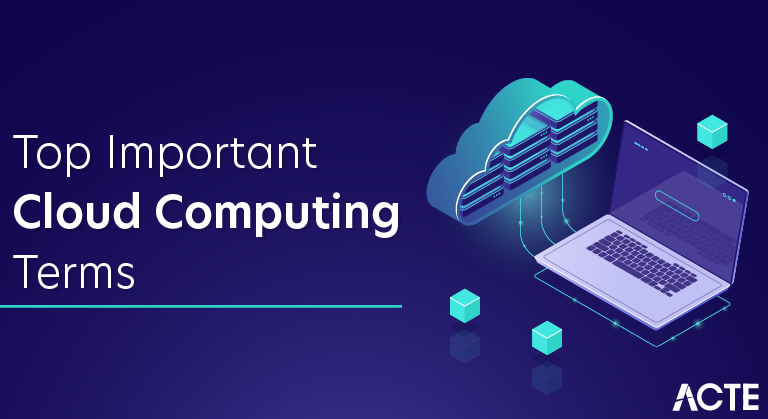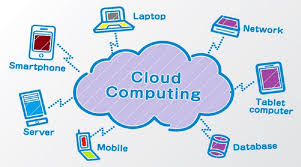
Top Important Cloud Computing Terms – Expert’s Top Picks
Last updated on 15th Jul 2020, Blog, General
Amazon Web Services (AWS)
Amazon Web Services is a suite of cloud computing services that make a comprehensive cloud platform offered by Amazon.com. AWS offers over three dozen cloud services spanning the IaaS, PaaS, and SaaS models of cloud computing, and is the most popular cloud service provider, with nearly 30% global market share in cloud IaaS, as of 2015. Well-known AWS services include Amazon EC2, Amazon Elastic Beanstalk, and Amazon S3.
Application Programming Interface (API)
An application programming interface (API) is an interface that allows the user to access information from another service and integrate this service into their own application. Through a set of defined requests, the asking application is allowed to access limited pieces of the called upon application’s functionality. APIs are used to share limited functionality between programs. One example of an API is the Facebook share button on this page, another is Yelp’s use of Google maps to display nearby restaurants.
Backend-as-a-Service (BaaS)
Backend as a service (BaaS), or mobile backend as a service (mBaaS) is a model of cloud computing in which the vendor provides web and mobile application developers with tools and services to create a cloud backend for their applications. BaaS vendors typically use custom SDKs and APIs to give developers the ability to connect their applications to backend cloud storage and features such as user management, push notifications, and social network integration.
A cloud computing model, infrastructure, data, and software are hosted by the vendor and delivered to the user as a service, much like a utility company would deliver water or electricity.
According to the official NIST definition, there are five essential characteristics of cloud computing: on-demand self-service provisioning of resources, broad network access, resource pooling, rapid elasticity, and measured service.
The three main cloud computing models are infrastructure as a service, software as a service, and platform as a service.
Cloud Foundry
Cloud Foundry is an open-source cloud platform as a service that was originally developed as a joint venture between VMware, EMC, and General Electric, and is now owned by Pivotal Software of public, private, and hybrid cloud environments.
Cloud Marketplace
A cloud marketplace is an online marketplace, operated by a cloud service provider (CSP), where customers can browse and subscribe to software applications and developer services that are built on, integrate with, or supplement the CSP’s main offering. Amazon’s AWS Marketplace and Microsoft’s Azure store are examples of cloud marketplaces.
Cloud Migration
Cloud migration is the process of transferring all of or a piece of a company’s data, applications, and services from on-premise to the cloud.
Customer Relationship Management (CRM)
Customer Relationship Management (CRM) applications allow a business to manage relationships with current and future customers by providing the business with tools to manage sales, customer service, and technical support roles. SaaS CRM applications, such as Salesforce.com, are very popular.
DevOps
An amalgamation of “development” and “operations,” DevOps is the combination of tasks performed by an organization’s applications development and systems operations teams.
The DevOps software development method emphasizes collaboration, communication and integration between developers and other IT personnel with the goal of streamlining software development and quality assurance.
Elasticity
In cloud computing, elasticity is a term used to reference the ability of a system to adapt to changing workload demand by provisioning and deprovisioning pooled resources so that provisioned resources match current demand as well as possible.
Enterprise Application
An enterprise application is an application (or software) that is intended for large scale use by a (large) business.
Enterprise Resource Planning (ERP)
Enterprise Resource Planning (ERP) software allows a business or organization to manage a suite of integrated applications which are used to collect, manage, and store data on a variety of business activities. ERP solutions are often offered as a service.
Google Cloud Platform (GCP)
Google Cloud Platform (GCP) is a comprehensive cloud platform offered by Google, Inc. that consists of both infrastructure as a service (IaaS) and platform as a service (PaaS) offerings.
Infrastructure As A Service (IaaS)
Infrastructure as a Service (IaaS) is a model of cloud computing in which the vendor hosts virtualized computing resources, as well as network and storage resources, and provides them to the user as a service via the internet.
Integrated Development Environment (IDE)
An integrated development environment (IDE) is an application that provides a programming environment for developers. An IDE typically includes a code editor, automation tools, and a debugger
Load Balancing
The process of distributing computing workloads across multiple resources, such as servers. In cloud computing, a load balancer acts as a reverse proxy and distributes application traffic to multiple servers in order to prevent any single application server from becoming a point of failure.
Microsoft Azure
Microsoft Azure, formerly known as Windows Azure, is Microsoft’s cloud computing platform. Azure was originally launched as a PaaS solution but now provides both PaaS and IaaS services.
Middleware
Middleware is software that connects software components or enterprise applications.
Multi-Cloud
A multi-cloud strategy is the concurrent use of separate cloud service providers for different infrastructure, platform, or software needs. A multi-cloud approach can help prevent vendor lock-in, and may help an enterprise deal with diverse workloads and partners. However, a multi-cloud approach can complicate many processes, such as security and governance, and a Cloud management platform is recommended for this approach.
On-Premise
On Premise technology is software or infrastructure that is run on computers on the premises (in the building) of the person or organization using the software or infrastructure. Microsoft Office Suite is an example of on-premise software because it needs to be installed on the computer that runs it, while Office365 is not, because it is accessed via the internet and run remotely.
Open Source
Open Source is a development model in which a product’s source code is made openly available to the public. Open source products promote collaborative community development and rapid prototyping. OpenStack and CloudFoundry are examples of an open source cloud computing platform.
Personal Cloud
An example of cloud washing, Personal Cloud is a marketing term often used to describe network attached storage (NAS) devices. A NAS device is a computer connected to a network that provides data storage services to other devices on the network.
Platform
In computing, a platform is defined as a computer system that applications run on, or as a base of technologies on which other technologies (such as applications) are built.
Platform as a Service (PaaS)
Platform as a Service (PaaS) is a model of cloud computing in which a vendor provides the hardware and software tools necessary to create, deploy and manage applications at scale to the user via the internet, as a service.
Private Cloud
A private cloud is a cloud infrastructure that is provisioned for use by a single organization of multiple users. A private cloud cab is managed and operated by the organization, a third party, or some combination of them, and it can exist on or off premises.
Public Cloud
A public cloud is a cloud infrastructure that is hosted by a cloud services provider and is made available to the public via the internet.
Scalability
Scalability is the ability of a process, system, or framework to handle a growing workload. In other words, a scalable system is adaptable to increasing demands. The ability to scale on demand is one of the biggest advantages of cloud computing.
Service Level Agreement (SLA)
A service level agreement (SLA) is a contractual agreement between a customer and a cloud service provider (CSP) which defines the level of service, availability and performance guaranteed by the CSP.
Shared Resources
Shared Resources, also known as network resources, are computing resources that can be accessed remotely through a network, such as a Local Area Network (LAN) or the internet.
Software As A Service (SaaS)
Software as a service (SaaS), is a model of cloud computing in which applications (software) are hosted by a vendor and provided to the user as a service. SaaS applications are licensed on a subscription basis and are made available to users over a network, typically the internet.

Because SaaS applications can be accessed at any time, at anyplace, and on any platform, they have become a popular model for delivery of many business applications. A well-known example of SaaS is Microsoft’s Office 365, which provides Microsoft’s famous suite of productivity software— including MS Word and Excel— as a service.
User Interface (UI)
User interface (UI) is the way that the user and computer system interact.
User Experience (UX)
The nature of a user’s interaction with and perception of a system.
Virtual Desktop Infrastructure (VDI)
Virtual desktop infrastructure (VDI) is a desktop operating system hosted within a virtual machine.
Virtual Machine (VM)
A virtual machine is a software computer that runs an operating system or application environment, just as physical hardware would. The end user has the same experience on a VM as they would on dedicated hardware.
Essentially, a VM is a machine within a machine. By running VMs, a hardware computer can run multiple instances of the same operating system. Applications running on separate instances cannot interfere with each other, so if one app crashes, it will not affect apps on other VMs.

